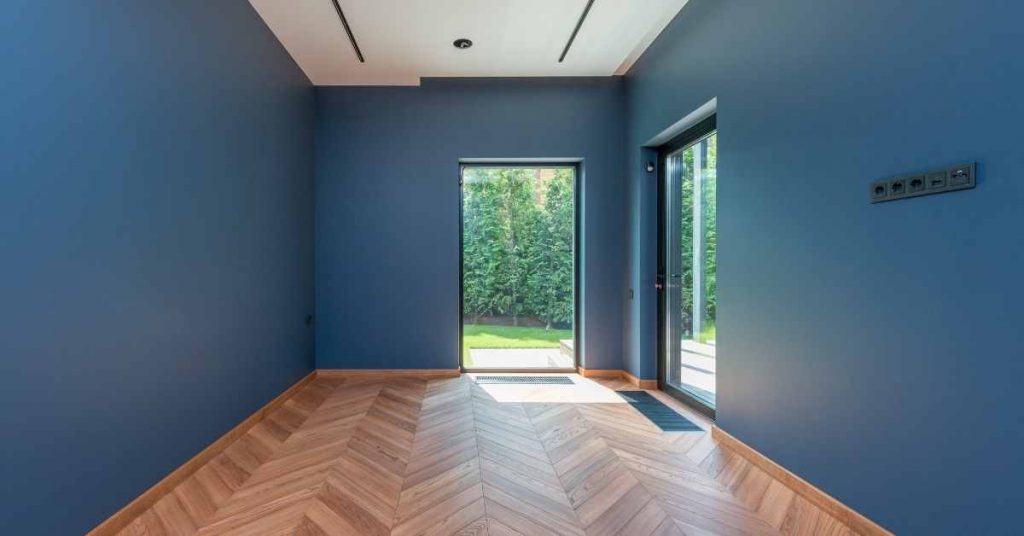
The creative possibilities of acrylic wall painting are nearly endless. Your entire wall may serve as a clean canvas for you to express your individuality and creativity or acrylic paint will help you redecorate and renovate your rooms.
There are so many different kinds of paint, and if you’re interested in murals, you might wonder, “can you use acrylic paint on walls?”
Acrylic paint may be used on interior and exterior walls for murals and renovation. It sticks permanently to plaster walls, concrete, and wooden walls. It will last longer if you prime the surfaces and finish them with a sealer.
In this post, we’ll go over everything you need to know and give tips on how to properly use acrylic paint on walls. If you’re ready to get started on your mural, let’s get started!
Table of Contents
Can you use acrylic paint on walls?
Acrylic paint is one of the most widely used forms of paint. It is a water-based, fast-drying paint composed of microscopic plastic acrylic resin and pigment particles.
Because it is water-based and long-lasting, it is an excellent option for any project.
Compared to oil-based or latex paints, acrylic paint provides more vibrant color and a more durable barrier for the walls, making it the ideal option for painting walls.
Acrylics are very flexible and may be used on any surface, as long as it is clean and dry and has no wax or oil on them. Thus, you may use acrylics on a wide variety of surfaces — including walls.
It is not only a colorful and versatile paint, but it also dries quickly and typically has a considerably less irritating odor than oil-based paints.
Acrylic paint may be slightly water-resistant, but it is not completely waterproof. Using a prepared surface, the right paint brand, and finishing with a sealant after the paint has dried can all increase the paint’s resistance to moisture.
Read also: How to Prime Wood for Acrylic Painting
Types of Acrylic Paint
Many types of acrylic paints are available to painters, and the difference lies in the acrylic binders used. Here is a list of the different acrylic paints you can use on walls.
Acrylic enamel
Enamel paint is a type of oil-based paint often used for the external walls of a building.
Acrylic enamel paints are far more durable because they harden into a protective coating once they dry.
Acrylic latex
Latex paint is typically used when painting larger areas such as walls and ceilings. When compared to other types of paint, latex-based paint is surprisingly affordable.
Similar to acrylic paint, latex paint is water-based and comes in a broad range of colors and textures.
Acrylic craft paint
Acrylic craft paint is versatile, and ideal for both novice and professional artists because of its flexibility and short drying time. It’s ideal for painting murals on interior walls.
However, it is only suitable for small projects. If you want to repaint your walls, regular wall paints are cheaper and will last longer than craft acrylic, which might end up costing you more.
They’re versatile enough to be used on various materials besides canvas, including wood, metal, cloth, and even ceramics. They’re used for ornamental painting and imitation finishes on everyday goods.
Acrylic paint vs. wall paint: Which is better?
Wall paints often refer to acrylic latex or latex paints, whereas “100% acrylic” refers to pure acrylic paint for art. The primary distinction between these two paints is the binder upon which they are based.
Acrylic paint has more chemical components than latex paint. Acrylic paint has better elasticity than latex paint due to its chemical composition. As a result, acrylic paint will handle temperature changes better than latex paint.
The water-based nature of Latex paint makes them washable on walls.
On the other hand, the chemical composition of acrylic paint requires paint thinners for application, requiring caution while handling it.
Also, acrylic paint is more commonly used for artwork, whereas latex paint is used for painting residential and commercial buildings.
Keep reading: Acrylic vs Latex Paint: Which is Better and What is The Difference?
Because environmental conditions and how the space is used vary from room to room, different types of paint and different level of sheens of latex or acrylic latex paint will be suitable for each specific area:
- Satin vs Semi-Gloss Paint: Everything You Need to Know
- Satin vs Gloss: Which is Ideal for your Home Decor and Painting?
- Satin vs Matte: Which Paint Makes for a Good Finish?
For optimal results, it’s best to choose a different paint for each room in the house, as they each have their own unique lighting, activities, and microclimates.
Here’s a table to show you the types of paint you can use for different rooms.
| House Room | Recommended Type of Paint |
| Bedroom | Acrylic latex |
| Bathroom | Latex enamel |
| Living Room | Latex paint |
| Kitchen | Latex enamel |
| Ceiling | Latex paint |
| Shower Walls | Latex enamel/ Epoxy paint |
| Trims, windows, and cabinets | Acrylic latex paint |
| Drywall (Interior/ Exterior) | Acrylic latex |
| Brick Walls | Acrylic latex |
| Wall Panels | Interior latex paint |
| Concrete Walls | Masonry paint/ Acrylic Latex/ Epoxy |
| Basement | Latex acrylic |
Best acrylic paint for walls and wall art
The type of acrylic paint you will use will depend on your project. Acrylic paint can be used for interior, and exterior walls, or murals.
Here are some of the acrylic paints I recommend using in different settings.

- If you’re painting interior walls, I recommend Kilz Complete Coat Paint + Primer as it is a universal interior/exterior paint with excellent durability and hundreds of happy home renovators. It is also available in 736 colors (I could not believe it!!!) and flat, satin, and semi-gloss sheen.
If you are using wall paint without a primer in the composition, trusted brands like Rust-Oleum recommend using Zinsser Bulls Eye Primer (it’s universal for any surface)
- For outside walls, I recommend this Glidden paint and primer in one. You can use it for residential and commercial buildings as it provides outstanding coverage and protection.
It’s a great value considering it’s excellent in adhesion and resists cracks, fading, dirt, mildew, and peeling. The fact that it comes with primer saves you time and money!
- If you’re going to paint murals, I highly recommend using Liquitex Acrylic Paint for small murals. This paint is incredibly versatile and reliable.
It also has a rich pigment with a smooth consistency, so it’s easy to mix right from the tube. Plus, it comes in different colors.
For bigger projects indoors and outdoors try this Chroma acrylic mural paint, it comes in a bigger volume and just a little paint goes a long way. Extremely durable on wood, concrete, and other walls doesn’t fade quickly, and is easy to wash off from hands.
How to apply acrylic paint on walls

In painting wall art and murals, here are the things you need:
- Paint primer (If the paint comes 2 in 1 paint and primer, you can skip this)
- Acrylic (Acrylic Latex) paint
- Flat paint brushes and rollers with a tray
- Painter’s tape
- Stepladder
- Something to cover the floor (you can use drop cloth)
Here is a short, easy-to-follow guide for painting walls with acrylic paint.
- It’s important to get the wall and supplies ready to go before starting to paint. Cover the floors first of all! To prepare your walls for painting, you need to vacuum up any dust settled there. Also, sanding it down beforehand improves paint coverage and durability.
- After sanding and cleaning your walls thoroughly, use a damp cloth to remove any remaining dirt and dust particles adhering to the surface of the walls. Then, let it dry.
- After the wall has dried, you can prime the walls. The primer acts as an adhesive and strengthens the durability of the acrylic paint for walls. You can use any water-based primer. I recommend Ronan Prime-All or the bestselling Zinsser Bulls Eye Primer.
Skip the step if the paint you got is 2-in-1 primer+paint!
- Once the primer has fully dried, you can start painting the walls. Begin by going around the edges with a roller starting from the highest point. Then paint the wall following a zig-zag pattern. It will help to get the paint even and cover the walls better. Depending on your preference, you can paint the wall with 2-3 coats of acrylic paint. Wait between coats for 1-4 hrs.
- It’s safe to leave your freshly painted walls alone to dry at this point. The paint will be dry to the touch within 6 hours but it is recommended to leave the room for 24 hours to fully dry (and get rid of the smell if any).
Wall art and murals with acrylic paint

Acrylic paints are ideal for creating murals since they can be applied on practically any surface, including walls, floors, and ceilings.
They are well-known for their rapid drying time and adaptability, both of which are important qualities in wall paint.
Acrylic paints are versatile and may be used both indoors and outdoors without damaging the wall surface. They’re a lot more cost-effective than oil paints for walls, yet they look virtually as good.
You may pick any commercial paint off the shelf, however, 100% acrylic resins may provide the best results. Satin and eggshell finishes are best for murals.
For painting murals with acrylics, I recommend using Chroma acrylic mural paint (both indoor/outdoor) or Liquitex Acrylic Paint (indoor only). Such regular acrylics will need a primer and a top coat to resist dirt, moisture, and fading.
Check also: Best Acrylic Paint: 20+ Brands Reviewed for Beginners [From Cheap to Pro]
How to paint a mural using acrylic paint

Supplies
- Paint: Liquitex Acrylic Paint or Chroma acrylic mural paint
- DIY cleaning product (lemon+warm water+vinegar)
- Liquitex Matte Medium (serve as a primer)
- sandpaper
- paintbrushes
- Liquitex Gloss Varnish (as isolation coat)
- Liquitex Soluvar (as ultimate protection and for easy cleaning)
Prep the wall for the mural
Liquitex recommends cleaning the wall for the mural with citrus-based cleaning products (you can use DIY citrus+water solution) and sanding it before painting.
If there is mold, Liquitex recommends mixing bleach with water in a 1:3 ratio. Rinse twice afterward and let dry.
The matte medium can serve as a primer if you need one. Apply 1-2 coats max and let them dry.
Test a small area to make sure the paint sticks to the wall. If all is good – proceed to sketching your future mural.
If not, you may apply a coat or two of gesso.
Transfer the sketch
After preparing the wall by cleaning, sanding, and priming it, you need to transfer your artwork to the wall.
No matter what transfer method you will choose it is recommended to fix it with a coat of 50% Matte Medium mixed with distilled water.
How to transfer your idea onto the wall:
1) Grid Method
Using a grid, you can easily transfer your artwork on the wall by outlining each box from your artwork to its corresponding box on the wall.
For instance, if you cut a 1×1 foot picture into 10 equal sections across and down, you’ll have 100 individual boxes.
Section the size of the wall into columns and rows evenly. Afterward, move the artwork from the paper boxes to the matching wall boxes.
Once you’ve filled all of the boxes, you’ll have a replica of your paper artwork on the wall.
2) Free-Hand Method.
You don’t need to be precise when painting florals, botanicals, doodles or abstract paintings.
If you’re doing a similar project, you can always paint free-hand and let the ideas come into life on your mural.
3) Projector Transfer Method.
For highly detailed artworks, such as photographs, a pro art projector transfer is the best option. This makes tracing lines and shapes, and coloring easy.
4) Stencils.
Stenciling is a common method for creating murals because it does not require any specialized training or talent to do.
You can buy stencils for anything, including letters, numbers, numbers, wildlife, botanicals, planets, and more.
You can use stencils to outline your mural and add the details later.
- To stencil, just tape it on the wall.
- Keep the stencil steady with one hand while filling it in with color using the other.
- To avoid paint buildup, apply paint near the edges using a sweeping, circular motion.
- Be careful not to get paint on the edges of the stencil, or they will be ruined when you remove it.
- To finish, take off the stencil and add details and finishing touches.
I recommend Stencil1 Stencils. They offer different beautiful patterns you can use for various projects.
Once your sketch is up there, get to the job! Paint it 🙂
How to seal acrylic paint on walls
Using a paint sealer will protect your painting from stains, fading, or scuffs.
Sealants can be used in murals, and walls indoors or outdoors, but some work better than others in either setting.

Some sealants require diluting. It’s best to follow the manufacturer’s recommendations for the appropriate sealant-to-water ratio.
Some sealants may be scraped off years later, allowing you to apply a new coat and extend the life of your painting.
They can also damage your floor, so take precautions before you start. You should protect the floor with a drop cloth just like you would while painting a wall.
How to seal murals
You should seal your mural paintings, particularly if they’re going to be outdoors.
There are a couple of different types of sealants you can use.
- Polyurethane
- Gloss Varnish (as isolation coat) + Liquitex Soluvar
With polyurethane like Minwax, it’s easy, you just apply 1-2 coats and let it dry overnight.
But Liquitex suggests using a two-step approach:
- Apply 1-2 coats of isolation coat, ex Liquitex gloss varnish or special isolation coat to protect the painting itself from being removed or damaged. Let it dry for 24 hours.
- Apply Soluvar varnish. It is a removable varnish, so if it starts to yellow, you can remove it and reapply a fresh coat. Now, if you would skip the isolation coat, you wouldn’t be able to carefully remove Soluvar – it would pull the mural with it. So don’t skip the first step if you are going with a varnish!
Using a wide paintbrush, apply the sealant in a crosshatch pattern. Start in a corner and work your way across the wall. Applying the sealant in like this will help achieve a more uniform appearance.
1-2 layers will be enough, wait 24 hours in between the coats. Soluvar comes in matte and gloss, and if you want a satin finish, just mix them 🙂
Read also: Best Isolation Coat for Acrylic Painting: Is It Necessary?
How to Seal Freshly-Painted Walls
- Polyurethane for wooden walls OR
- Top coat (optional)
For freshly-painted walls, it’s always best to wait at least 2 weeks before applying any type of top coat. This gives the paint plenty of time to cure and harden.
At the same time, most wall paint just doesn’t need a top coat and people don’t do it.
Acrylic sealant sheen and drying time
There are different types of paint finishes, and the common ones are glossy and matte.
Glossy sealants create a shiny, protective layer over the paint. They’re ideal for use in high-traffic areas or in rooms that get a lot of sunlight.
Matte sealants, on the other hand, don’t create any sheen. They’re perfect for areas where you want the paint to look its natural best.
To apply sealant on walls, use a brush or roller to spread it evenly over the surface. Work in small sections and make sure to apply a moderate amount per layer
If you apply too much sealant, it will take longer to dry and could cause the paint to crack or peel.
If you apply it too thinly, it won’t provide adequate protection. Once the sealant is dry, your walls will be protected from dirt, water, and other damage.
Another thing to take note of is that even if a sealant seems dry to the touch, it hasn’t set yet and is still vulnerable to harm until it has dried.
Drying and curing durations may vary depending on environmental factors like humidity and temperature, so it’s essential to follow the manufacturer’s instructions.
The curing time for acrylic sealants can be up to 72 hours.
When painting a room, it’s best to wait at least 4-6 hours before doing anything else, such as moving furniture. I would not recommend sleeping in the room if the odor is still present.
Is acrylic paint washable on walls?
Yes, acrylic paint and latex paint on walls are washable.
However, if you want to wash off acrylics, you can do it with water only while the paint is still wet.
Keep in mind, though, that these colors will fade over time and may need repainting. You need to seal your mural with varnish to make it resistant to weather and dirt, and easy to clean.
Different sheens have different resistance to regular cleaning, though with glossy being the most resistant and matter – the least durable.
How to remove acrylic paint on walls
Since acrylic paint dries quickly, you’ll need to act swiftly to remove it from unwanted areas on the wall.
Once it dries, it will be more challenging to remove, but not impossible. Acrylic paint is similar in texture to glue, so you should use a solvent to help you remove it.
You’ll need something to lessen its grip, at the very least. Here are some ways to remove acrylic paint from walls.

How to remove Acrylic Paint Stains from the wall
1. Soap and Water
Soap and water should remove any splashes or spills as long as they are still wet. You should use a sponge or towel dipped in liquid soap to clean the area thoroughly.
Make a solution of liquid soap and water, then apply it to the areas. Allow it to sit for a while, then scrub it with mild detergent.
2. Baking Soda Paste
To remove stubborn stains, use baking soda. Make a paste by combining baking soda and water. Let the paste remain on the paint stain for a few minutes after applying it. After that, remove the paint by scrubbing it with a sponge.
3. Vinegar
Vinegar may also be helpful in removing acrylic paint. Use heated vinegar to remove tough stains by heating it in a pot or microwave. Depending on how strong the vinegar scent is, you might need to use a cleaning afterward to get rid of it.
4. Rubbing Alcohol
Rubbing alcohol is quite strong and will dissolve acrylic paint. Take some cotton and soak it in rubbing alcohol.
Then, simply dab the stain with the cotton ball and wait for it to dry. Keep in mind that it may take some time for the paint to be entirely dissolved.
5. Acetone
Apply as much acetone as needed to remove the acrylic paint. The smallest stains can be removed by spraying acetone onto a cloth and then rubbing it over the affected area.
Put the acetone straight onto the paint if the stain is particularly stubborn.
After that, wash the acetone-soaked paint residue away using a scrub brush. Just keep rinsing and repeating until the spots disappear.
6. Sanding
Using sandpaper may appear to be a bad option, as there is a chance of damaging the original wall paint. However, dried acrylic paint may be removed with sandpaper if done gently.
Use a light wiping motion and concentrate on the stain while you sand with minimal pressure. When you’re done, use one of the aforementioned methods to get rid of the residue.
7. Scraping
You can use a scraper if the stains are really thick and have dried, but be careful not to scrape too hard or you may end up chipping the wall’s original paint in the process.
Once the majority of the stain has been removed, use any of the solutions or solvents previously mentioned to get rid of any remaining residues.
Acrylic paint on walls FAQ
Now, let’s move on to the frequently asked questions about acrylics.
Is acrylic paint peeling off walls?
Acrylic paint won’t peel off walls if applied correctly. It will only come off walls if it was painted over old oil-based paint or put on a dirty surface.
Wall preparation is an essential initial step before applying acrylic paint. Clean the walls to get rid of the dust, sand them to get a clean surface, then prime them to seal holes and increase adhesion. Acrylic paint might peel if the wall is not prepared first.
Another thing to remember is that if you use acrylic paint over oil-based paint, the acrylic will also peel off. Since acrylic paint is water-based, it cannot be used to cover oil-based paint.
So if you want to paint over oil-based paint with acrylic, you need to prepare the surface with water-based paint first.
Can you use craft acrylic paint on walls?
Yes! You can use craft acrylic paint on walls. However, the kind of project that you are working on will determine the kind of acrylic paint that you need to use. It’s best to use higher-end craft acrylic paint for wall painting.
Also, remember to prepare the surface. Clean, sand, and prime the wall before using your acrylics over it. Also, make sure to apply a sealer over your painting to make it last longer.
Can you use acrylic latex paint on walls?
Yes, acrylic latex paint may be used on walls. Acrylic latex paint is meant to last longer on surfaces like walls. Because of its high coverage and long lifespan, this acrylic paint is the most acceptable option for painting walls.
How long does acrylic paint last on walls?
Acrylic paints are both versatile and long-lasting. Acrylic paints have a shelf life of up to ten years if unused. When applied to walls, however, its lifespan drops to between 5 and 8 years.
Garages are great places to keep a supply of acrylic paints you won’t be using anytime soon, as it prevents the paints from drying out, freezing, and cracking.
Summary
Acrylic paint is the best choice if you’re looking for paint to use on walls.
Although they come in different types, some are ideal to use in different kinds of rooms because of different environmental conditions.
I hope this article has helped you learn more about painting on walls using acrylics. What do you think of wall acrylic paintings? Let me know now in the comments section.

Masha Eretnova, born in 1991, is a Buenos Aires-based certified teacher, artist, and member of the Professional Artist Association with 20+ years of personal painting journey.
She started painting and drawing very early and is now an international abstract artist and educator passionate about acrylic painting, gouache, and crafts.
Her works are part of international exhibitions and contests, including ArtlyMix (Brazil), Al-Tiba 9 (Spain), Exhibizone (Canada), Italy, and many more.
Besides her artistic pursuits, Masha holds a post-grad diploma in Teaching Film Photography and 2 music school diplomas: piano and opera singing.
